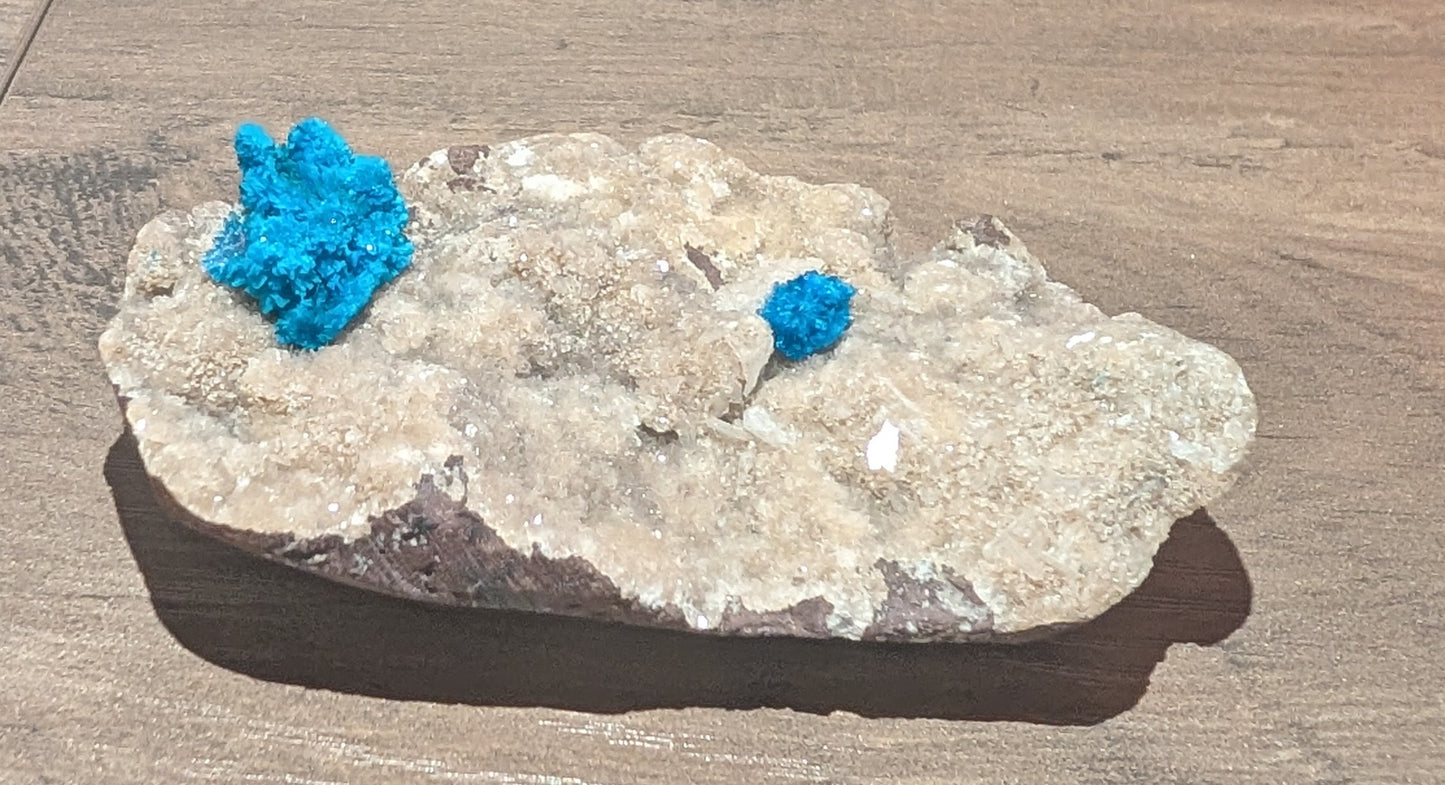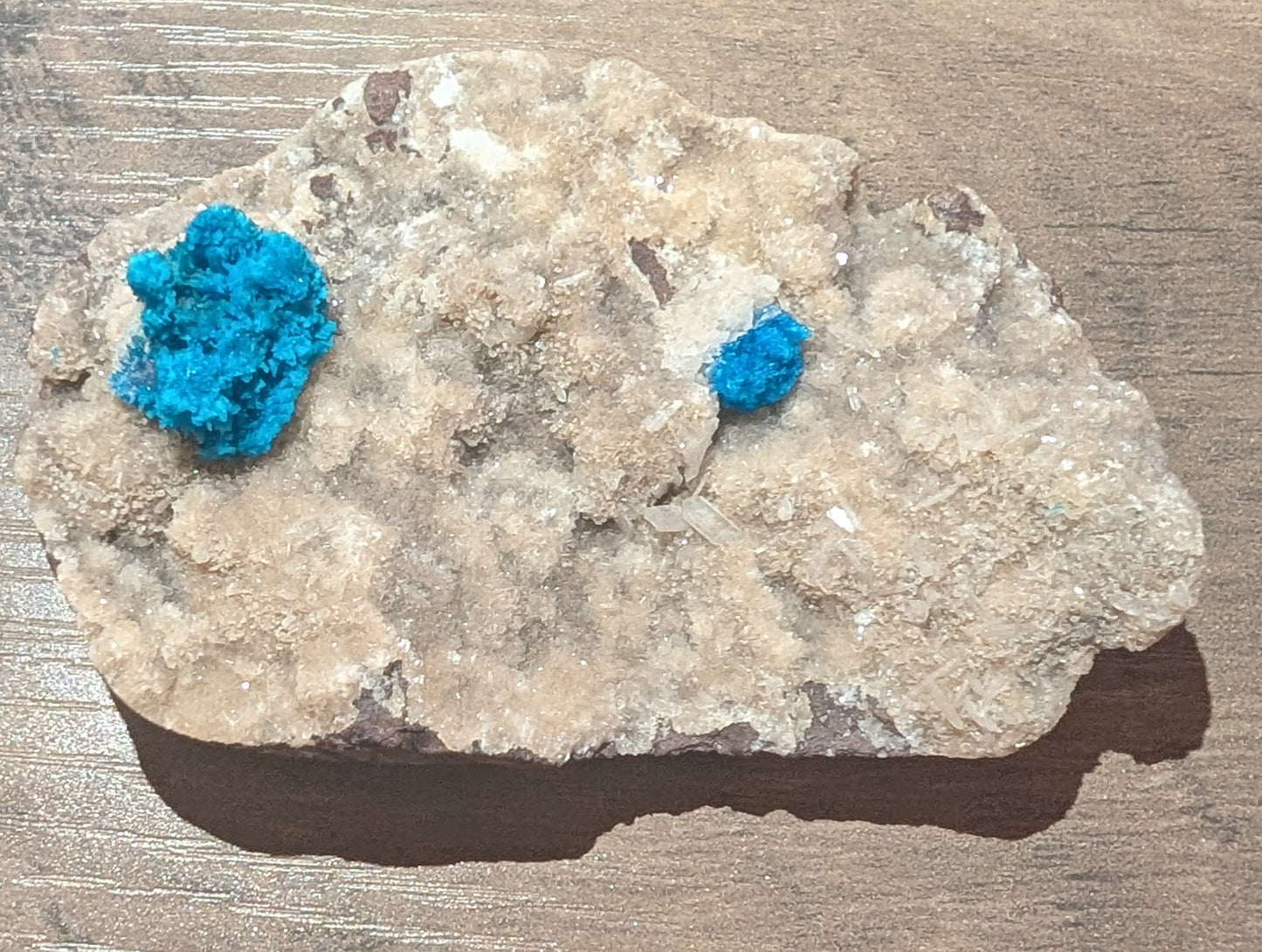Auglocqnuk
Pentagonite and Cavansite on Heulandite with Stilbite
Pentagonite and Cavansite on Heulandite with Stilbite
Couldn't load pickup availability
Cavansite and pentagonite are dimorphic minerals, meaning they share the same chemical composition, Ca(VO)Si₄O₁₀·4(H₂O), but have different crystal structures. Both are deep blue hydrous calcium vanadium phyllosilicate minerals, with their vibrant color derived from vanadium ions. They are primarily found in the Wagholi Quarry area near Pune, Maharashtra, India, within the Deccan Traps, a large igneous province formed by ancient volcanic activity. This location is the most significant source for high-quality specimens, although minor occurrences of cavansite have been reported in the USA and New Zealand.
Heulandite and stilbite are common associated zeolite minerals found in the same geological environment. Heulandite typically forms the basaltic matrix upon which the other minerals crystallize, while stilbite often appears as sheaf-like aggregates or radiating clusters, sometimes found on the surface of pentagonite or cavansite crystals. Calcite is also frequently associated with these minerals, appearing as cubic crystals on cavansite.
The formation of cavansite, pentagonite, stilbite, and heulandite in the Wagholi quarries is explained by a multi-stage mineralization model. It began with the deposition of heulandite through burial diagenesis in isolated vesicles and open spaces within the basalt. This was followed by multiple pulses of ascending, vanadium-bearing hydrothermal fluids through interconnected spaces. As the temperature of these fluids decreased (estimated between 120 °C and 200 °C) while pressure remained relatively low (0.01–0.03 GPa), cavansite and pentagonite precipitated first, along with stilbite. Cavansite typically forms radiating acicular prismatic crystals, often aggregating into spherulitic rosettes or balls. In contrast, pentagonite forms slender, elongated, prismatic crystals that frequently create star-like clusters or sprays, although the characteristic "five-pointed star" is now understood to be formed from six individuals. The crystallization sequence shows that cavansite generally precipitates before pentagonite, and stilbite crystallizes after pentagonite.
What makes these minerals unique is their rarity and the specific geological conditions required for their formation. The Wagholi Quarry, the primary source, has been both closed and overbuilt, making these crystals increasingly hard to find. The combination of cavansite and pentagonite in the same specimen, often with stilbite and calcite, is particularly prized by collectors due to the contrasting crystal habits and the stunning visual effect of the rich blue minerals against the zeolite matrix. The formation under relatively low-temperature and low-pressure conditions, consistent with the formation of other low-temperature zeolites like heulandite and stilbite, is a key factor in their unique occurrence
How do cavansite and pentagonite differ?
Cavansite and pentagonite are dimorphs, meaning they share the same chemical composition, Ca(V⁴⁺O)Si₄O₁₀·4H₂O, and are both calcium vanadium phyllosilicates with a vibrant blue color due to the presence of vanadium in the +4 oxidation state. They crystallize in the orthorhombic system and are found in similar geological environments, primarily within the Deccan Traps of India and a few other locations like Oregon, USA. Despite their similarities, they differ significantly in their crystal structure, physical appearance, and formation conditions.
The most notable difference lies in their crystal habit and morphology. Cavansite typically forms spherulitic rosettes, which are compact, ball-like clusters of short, blunt, needle-like crystals. In contrast, pentagonite also forms from spherulitic rosettes but grows into distinct, individual, elongated prismatic crystals with pointed terminations that can extend up to several centimeters in length. These elongated crystals are often described as acicular and can exhibit a characteristic five-branched, pentagon-like cyclic twinning, which is a key identifier for pentagonite. This twinning is not observed in cavansite.
Their physical properties also differ. Pentagonite generally exhibits a deeper, more intense ultramarine blue color compared to the brighter, teal-blue hue of cavansite. The structural differences between the two minerals are profound. Cavansite has a more compact structure with 8-membered rings of SiO₄ tetrahedra joined by 4-membered rings, and its calcium atoms are coordinated by eight oxygen atoms, four from silicate sheets and four from water molecules. Pentagonite has 6-membered rings of SiO₄ tetrahedra, and its calcium atoms are coordinated by only seven oxygen atoms, with one water molecule hydrogen-bonded to other water molecules and silicate oxygen atoms. This structural difference results in cavansite having a lower ground-state energy and a slightly smaller volume (about 2.7% less) than pentagonite.
These structural and energetic differences explain their relative rarity. Cavansite is more common and is considered a low-temperature form, while pentagonite is rarer and is thought to form under higher-temperature conditions. Theoretical studies suggest that the lower energy state of cavansite makes it the more stable phase under typical conditions, and the probability of pentagonite formation is very low at temperatures below 650K. The water molecules in cavansite are also less tightly bound than those in pentagonite, making them easier to remove, which may influence their stability and formation.
Due to their visual similarity, misidentification is common in the mineral market, and the term "pentagonite" is sometimes used abusively to justify higher prices for specimens that are actually cavansite. Without specialized analysis, such as X-ray diffraction, it is impossible to definitively distinguish between the two based on appearance alone.
Share




